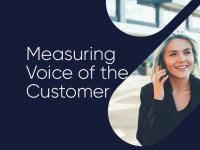25 surefire ways to improve customer satisfaction
Discover our curated list of strategies and examples for improving customer satisfaction and customer experience in your call center.
CallMiner Outreach is here! |Learn about the future of CX

Solutions
Products
Customers
Solutions
Products
Customers
Resources
Company
The Team at CallMiner
January 04, 2022


Although customer satisfaction may seem like a simple concept to grasp – your customers are either reasonably satisfied or they are not – there are numerous ways to track it, measure it and improve it.
Choosing the right type of customer satisfaction measurement to suit your needs can completely change how you do business. We take a closer look at the best options below.

There are many ways to measure customer satisfaction, and each of these can be thought of as a means of measuring a different facet of a customer's experience with your brand. For instance, a standard customer satisfaction score (CSAT) might tell you how your customers are feeling at a given moment, while a Net Promoter Score helps you understand how confident they are in the quality of your product or service.
Below, we touch on the most common types of customer satisfaction measurements companies track to guide their development.
This is the simplest type of customer satisfaction metric available. The CSAT survey asks customers how satisfied they are with a given interaction point blank. To answer, customers are given a choice between any number in a given range, such as 1-3 or 1-5 with the lowest number being the least satisfied and the highest number being the most satisfied.
Despite its inherent simplicity, this standard survey is extremely versatile. You can ask customers how satisfied they were with any interaction, and the results will remain as actionable as ever. However, truly dissatisfied customers might not stick around to provide the sort of feedback you need the most. This can cause CSAT survey results to skew a bit more positive than they likely are.
The customer effort score (CES) metric is similar in its simplicity to CSAT, but it differs in its delivery. Where a customer satisfaction score asks customers how satisfied they are, a customer effort score asks them how easy a given interaction was for them to handle. This distinction makes CES useful for sleuthing out issues with your customer-facing processes and services. Customers who have reported an interaction to have been "easy" are likely satisfied with the outcome and process.
Greater customer effort often implies lower satisfaction and vice-versa, but it may be wise to combine this metric with others for a better understanding of the factors at play.
The rate at which your business loses customers to competition or your "churn" rate can be used as a type of customer satisfaction measurement as well. After all, customers who stop doing business with you are essentially voicing their opinion of your company loud and clear without necessarily saying a single word. Satisfied customers generally stick around, while dissatisfied ones move on to seek out superior alternatives.
Although this type of customer satisfaction metric does not quite give you any reasons for your customers' dissatisfaction, it does help flesh out the big picture of whether the people you serve are generally satisfied with what you are providing them.
Another type of customer satisfaction metric, the Net Promoter Score, tackles yet another question – how likely your customers are to recommend your service or product to other people. Your net promoter score is derived from a simple survey in which customers choose a number ranging from 1 to 10, with 9 or 10 being a very likely promoter and anything under 7 amounting to a probable detractor.
What sets Net Promoter Score apart from the other customer satisfaction metrics is that it is inherently broad in scope. When you ask customers to fill out a net promoter survey, you are essentially asking them how they feel about your brand overall rather than a specific interaction or offering. Promoters are satisfied with your brand overall and are willing to tie their own reputations to that of your company by encouraging people they trust to do business with you as well.
Customer satisfaction can and should be improved over time. With the help of the metrics explored above, you can begin to set development goals for your team and achieve these on a regular basis. Here are a couple of additional tips and best practices to give you a head start:
Overall, customer satisfaction is a measure of how happy your customers are with your product or service. The various methods for measuring and monitoring customer satisfaction can provide valuable insights into the factors and interactions that impact the customer experience and, ultimately, your company’s bottom line.
CallMiner is the global leader in AI-powered conversation intelligence to improve customer experience (CX). CallMiner delivers the industry’s most comprehensive platform to analyze omnichannel customer interactions at scale, combining deep domain expertise with cutting edge AI analytics and machine learning. By uncovering better intelligence, CallMiner enables companies to identify areas of opportunity to drive better experiences, ultimately leading to business improvement, growth and transformational change. CallMiner is trusted by the world’s leading organizations across all major verticals including technology, media and telecom (TMT), retail, manufacturing, financial services, healthcare, and travel and hospitality.